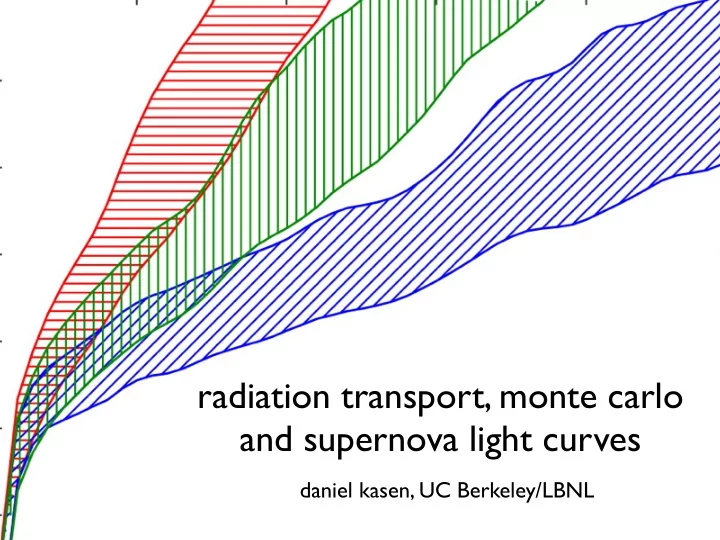

opacity terminology for example
sources of supernova opacity see karp (1977) pinto and eastman (2000) thomson optical interaction with free electrons scattering scattering/absorption from atomic lines UV/optical doppler broadened lines bound-free UV photo-ionization of atoms bremsstrahlung free-free infrared (free electron + nucleus) all of these depend sensitively on the composition and ionization state of the ejecta!
solar composition bound-free T = 10 4 , rho =10 -13 lines electron scattering e e r f - e e r f
pure iron composition T = 10 4 , rho =10 -13 lines electron scattering bound-free e e r f - e e r f
line interactions ~1/2 GB atomic data Local Thermodynamic Equilibrium (LTE) non-equilibrium (NLTE) CaII nxn matrix, where n = number of atomic levels (sparsity depends on number of transitions included)
line interactions ~1/2 GB atomic data Local Thermodynamic Equilibrium (LTE) non-equilibrium (NLTE) CaII nxn matrix, where n = number of atomic levels (sparsity depends on number of transitions included)
line interactions ~1/2 GB atomic data Local Thermodynamic Equilibrium (LTE) non-equilibrium (NLTE) FeII nxn matrix, where n = number of atomic levels (sparsity depends on number of transitions included)
line interactions ~1/2 GB atomic data Local Thermodynamic Equilibrium (LTE) non-equilibrium (NLTE) FeII nxn matrix, where n = number of atomic levels (sparsity depends on number of transitions included)
scp06f6 2005ap ptf09cnd 2008es 2006gy 2007bi type Ia ordinary core collapse supernovae
scp06f6 2005ap ptf09cnd 2008es 2006gy 2007bi type Ia ordinary core collapse supernovae more massive, opaque (longer diffusion time)
how to power a supernova light curve
how to power a supernova light curve • thermal energy released in the explosion shock, nuclear burning
how to power a supernova light curve • thermal energy released in the explosion shock, nuclear burning • radioactive decay of freshly synthesized isotopes: 56 Ni ( 52 Fe, 48 Cr, 44 Ti, R-process)
how to power a supernova light curve • thermal energy released in the explosion shock, nuclear burning • radioactive decay of freshly synthesized isotopes: 56 Ni ( 52 Fe, 48 Cr, 44 Ti, R-process) • interaction of the ejecta with a dense surrounding medium
how to power a supernova light curve • thermal energy released in the explosion shock, nuclear burning • radioactive decay of freshly synthesized isotopes: 56 Ni ( 52 Fe, 48 Cr, 44 Ti, R-process) • interaction of the ejecta with a dense surrounding medium • energy injection from a rotating, highly magnetized neutron star (magnetar)
thermally powered supernovae (Type IIP)
luminosity of thermal light curve energy deposited by the explosion
luminosity of thermal light curve energy deposited by the explosion the radiation energy drops in the expanding gas and takes a diffusion time to escape
luminosity of thermal light curve energy deposited by the explosion the radiation energy drops in the expanding gas and takes a diffusion time to escape simple estimate of supernova luminosity
luminosity of thermal light curve energy deposited by the explosion the radiation energy drops in the expanding gas and takes a diffusion time to escape simple estimate of supernova luminosity
luminosity of thermal light curve energy deposited by the explosion the radiation energy drops in the expanding gas and takes a diffusion time to escape simple estimate of supernova luminosity low radiative efficiency if initial radius is small! for a bright thermally powered supernova, must have R 0 >> R sun
scp06f6 2005ap ptf09cnd 2008es 2006gy 2007bi type Ia ordinary core collapse supernovae more massive (longer diffusion time)
scp06f6 2005ap ptf09cnd more energetic, larger radius 2008es 2006gy 2007bi type Ia ordinary core collapse supernovae more massive (longer diffusion time)
fixed E/M scp06f6 R = 10 4 R sun 2005ap ptf09cnd more energetic, larger radius 2008es 2006gy 2007bi R = 10 3 R sun type Ia ordinary core collapse R = 10 2 R sun supernovae more massive (longer diffusion time)
Type IIP core collapse supernovae explosion of red supergiant stars 1-D models (vary explosion energy) DK & woosley, 2009 E = B
recombination wave in Type IIP supernova opacity from electron scattering drops as ejecta cool and become neutral recombination at T ~ 6000 K
light curve scalings with recombination gives a Type II plateau light curve
light curve scalings with recombination gives a Type II plateau light curve the photosphere forms at the recombination front
light curve scalings with recombination gives a Type II plateau light curve the photosphere forms at the recombination front where the recombination temperature T i =~ 6000 K.
light curve scalings with recombination gives a Type II plateau light curve the photosphere forms at the recombination front where the recombination temperature T i =~ 6000 K. Using previous results for diffusion time: t sn ∝ E − 1 / 6 M 1 / 2 ej R 1 / 6 κ 1 / 6 T − 2 / 3 0 I L sn ∝ E 5 / 6 M − 1 / 2 R 2 / 3 κ − 1 / 3 T 4 / 3 . 0 ej I see Popov (1993), DK & Woosley (2009)
radioactivity powered supernovae
radioactively powered light curves most important chain: 56 Ni 56 Co 56 Fe
radioactive 56 Ni decay 8.8 days 100% electron capture 81% electron capture 113 days 19% positron production Important Gamma-Ray Line for 56 N i and 56 C o Decays 56 Ni Decay 56 Co Decay Energy Intensity Energy Intensity (keV) (photons/100 decays) (keV) (photons/100 decays) 158............ 98.8 847 100 270............ 36.5 1038 14 480............ 36.5 1238 67 750............ 49.5 1772 15.5 812............ 86.0 2599 16.7 3240 a 1562.......... 14.0 12.5 milne et al. (2004)
gamma-ray deposition by compton scattering since gamma-ray energies (MeV) are much greater than ionization potentials, all electrons (free + bound) contribute
gamma-ray deposition by compton scattering since gamma-ray energies (MeV) are much greater than ionization potentials, all electrons (free + bound) contribute change in photon wavelength angle between incoming and outgoing photon directions
Recommend
More recommend